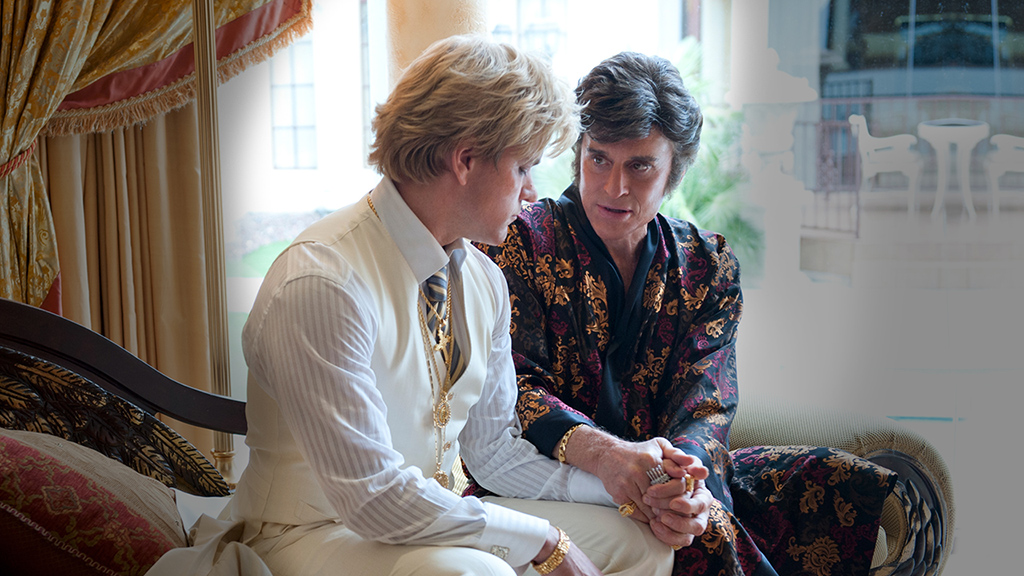It could almost be the result of a random movie project generator. Your subject is “the life of Liberace”. Your director? “Steven Soderbergh”. Next around on the wheel: “Todd Haynes” (who has some form with tragic showbiz stories and 70s kitsch) and “Michael Bay” (who might have taken a decidedly heteronormative approach to all the spectacle and boom-bang-a-bang hot-tub action).
Which is to note that Behind the Candelabra could have gone any which way, whether descending into terminal TV-movie worthiness (Soderbergh’s backers were the cable channel HBO, after all) or overdoing the swishing comedy and campy excess. The surprise, even among Soderbergh devotees, may be how restrained the film is: rooted in character, yet shot at arm’s length, with – one scene-setting burst of Giorgio Moroder aside – no music other than Liberace’s own to let us know where and how to feel.
For most of the film, we’re stranded on another planet, in the furthest outreaches of the showbiz galaxy – the tactics only helping to flag up the peculiarity and singularity of the world our entry point, Liberace’s all-American boytoy Scott Thorson (Matt Damon, repositioned somewhere between glowing farmhand and porno-Adonis), first strutted into circa 1977.
Part Saddam’s palace, part Paris Hilton pied-à-terre, the Casa de Liberace – a truly fabulous feat of production design by Howard Cummings – is a vast self-pleasuring splurge of homoerotic frescos and glittering trinkets, sandwiched by matching keyboard-themed canopies and floor tiles, and serviced by condescending houseboys in glute-hugging slacks.
Somewhere in there lurks its presiding intelligence, regarding the universe entire as something to be remodelled in his own image. When “Lee” Liberace (Michael Douglas, uncanny) baldly states “I was the first person on TV to look directly into the camera” (surely disregarding the contributions of countless newscasters?), we twig it’s highly likely he did so not so much for the connection with the audience as to catch his own reflection in the lens.
Soderbergh’s manner here is only slightly more relaxed. Wry amusement, drafting in a Rob Lowe or Dan Aykroyd to pep up individual scenes, gives way – as in a couple of graphic surgery interludes, stitched together to comprise the recent cinema’s grisliest makeover montage – to something more scientific. He’s compelled to ask how someone would go about getting a facelift or chin implant to look more like their younger self, or someone else. And, more crucially: why?
Naturally, it boils down to need and control, showbusiness’s twin engines since the year dot. Scott’s foster parents, a picture of normality, wonder why one grown man would want to adopt another, and such questions linger; there are dom-sub relationships, and then there’s the plain weird, and Soderbergh makes this one appear more unfathomable yet by framing it as glimpses through doors and in mirrors. Not even he attempts to get between these two, and whatever it was they had.
Shrewdly, Soderbergh and screenwriter Richard LaGravenese realise you can’t use this relationship to bang the drum for gay marriage, because a) Lee and Scott’s coupling couldn’t be tied in a neat knot, and b) it’s every bit as likely to alienate as it is to enthral. What the film can do, however, is put forward a case for Liberace as a true one-of-a-kind, a distinction even the pianist’s detractors might just nod through.
The appreciation of Liberace’s musical talents remains surprisingly unironic right from his introduction, performing a boogie-woogie routine that has the adoring greyhairs that made up his core crowd eating out of his hand – the kind of effortless showmanship that an up-down auteur like Soderbergh can only concede is difficult to maintain. Yet it’s balanced by an understanding of the off-stage torments that resulted from Lee’s desperate desire for image-control: if the film absolutely has to be taken up as a campaigning text, it might just work as a call to greater honesty among our entertainers.
You may be tickled, you may well be moved by the final moments, in which something like emotion (transcendent kitsch, maybe) bleeds into Soderbergh’s traditionally clinical worldview. Yet I suspect you can’t fail to notice the distinct chill of horror that lurks behind this candelabra, and which Soderbergh points up with his every detached camera angle.
Between the bodily transformations, the displays of human weakness, and the lawyers circulating within a world it proves very easy to get sucked into, and mortally difficult to escape from, the Soderbergh film Behind the Candelabra has most in common with isn’t the glitzy Ocean’s 11, nor last year’s whooping, hollering Magic Mike.
It’s 1991’s infamously unloved Kafka, from the stumbling beginnings of this director’s ever-confounding and varied career – and if Soderbergh can finally turn the raw materials of that flop into a lamé-covered, diamond-studded hit while effectuating his own escape from the entertainment business, it’ll be a remarkable note to go out on.
(MovieMail, June 2013)
Behind the Candelabra screens on BBC2 tomorrow night at 10.45pm.

No comments:
Post a Comment